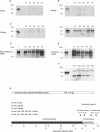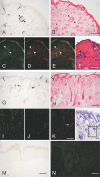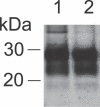Accumulation of pathological prion protein PrPSc in the skin of animals with experimental and natural scrapie
- PMID: 17530923
- PMCID: PMC1876502
- DOI: 10.1371/journal.ppat.0030066
Accumulation of pathological prion protein PrPSc in the skin of animals with experimental and natural scrapie
Abstract
Prion infectivity and its molecular marker, the pathological prion protein PrP(Sc), accumulate in the central nervous system and often also in lymphoid tissue of animals or humans affected by transmissible spongiform encephalopathies. Recently, PrP(Sc) was found in tissues previously considered not to be invaded by prions (e.g., skeletal muscles). Here, we address the question of whether prions target the skin and show widespread PrP(Sc) deposition in this organ in hamsters perorally or parenterally challenged with scrapie. In hamsters fed with scrapie, PrP(Sc) was detected before the onset of symptoms, but the bulk of skin-associated PrP(Sc) accumulated in the clinical phase. PrP(Sc) was localized in nerve fibres within the skin but not in keratinocytes, and the deposition of PrP(Sc) in skin showed no dependence from the route of infection and lymphotropic dissemination. The data indicated a neurally mediated centrifugal spread of prions to the skin. Furthermore, in a follow-up study, we examined sheep naturally infected with scrapie and detected PrP(Sc) by Western blotting in skin samples from two out of five animals. Our findings point to the skin as a potential reservoir of prions, which should be further investigated in relation to disease transmission.
Conflict of interest statement
Figures





Similar articles
-
Intraepithelial and interstitial deposition of pathological prion protein in kidneys of scrapie-affected sheep.PLoS One. 2007 Sep 12;2(9):e859. doi: 10.1371/journal.pone.0000859. PLoS One. 2007. PMID: 17848990 Free PMC article.
-
Preclinical deposition of pathological prion protein PrPSc in muscles of hamsters orally exposed to scrapie.J Clin Invest. 2004 May;113(10):1465-72. doi: 10.1172/JCI21083. J Clin Invest. 2004. PMID: 15146244 Free PMC article.
-
Detection of PrP(Sc) in rectal biopsy and necropsy samples from sheep with experimental scrapie.J Comp Pathol. 2006 Feb-Apr;134(2-3):115-25. doi: 10.1016/j.jcpa.2005.08.001. Epub 2006 Feb 7. J Comp Pathol. 2006. PMID: 16466737
-
Prion encephalopathies of animals and humans.Dev Biol Stand. 1993;80:31-44. Dev Biol Stand. 1993. PMID: 8270114 Review.
-
Molecular biology of prions causing infectious and genetic encephalopathies of humans as well as scrapie of sheep and BSE of cattle.Dev Biol Stand. 1991;75:55-74. Dev Biol Stand. 1991. PMID: 1686599 Review.
Cited by
-
Is the presence of abnormal prion protein in the renal glomeruli of feline species presenting with FSE authentic?BMC Vet Res. 2010 Aug 4;6:41. doi: 10.1186/1746-6148-6-41. BMC Vet Res. 2010. PMID: 20684771 Free PMC article.
-
Antiprion activity of cholesterol esterification modulators: a comparative study using ex vivo sheep fibroblasts and lymphocytes and mouse neuroblastoma cell lines.Antimicrob Agents Chemother. 2007 Nov;51(11):4141-7. doi: 10.1128/AAC.00524-07. Epub 2007 Aug 20. Antimicrob Agents Chemother. 2007. PMID: 17709472 Free PMC article.
-
Circulation of prions within dust on a scrapie affected farm.Vet Res. 2015 Apr 16;46(1):40. doi: 10.1186/s13567-015-0176-1. Vet Res. 2015. PMID: 25889731 Free PMC article.
-
Pruritus in familial Creutzfeldt-Jakob disease: a common symptom associated with central nervous system pathology.J Neurol. 2011 Jan;258(1):89-95. doi: 10.1007/s00415-010-5694-1. Epub 2010 Aug 21. J Neurol. 2011. PMID: 20725737
-
Prion strain targeting independent of strain-specific neuronal tropism.J Virol. 2009 Jan;83(1):81-7. doi: 10.1128/JVI.01745-08. Epub 2008 Oct 29. J Virol. 2009. PMID: 18971281 Free PMC article.
References
-
- Beekes M, McBride P. The spread of prions through the body in naturally acquired transmissible spongiform encephalopathies. FEBS J. 2007;274:588–605. - PubMed
-
- Beekes M, Baldauf E, Diringer H. Sequential appearance and accumulation of pathognomonic markers in the central nervous system of hamsters orally infected with scrapie. J Gen Virol. 1996;77:1925–1934. - PubMed
-
- van Keulen LJ, Vromans ME, van Zijderveld FG. Early and late pathogenesis of natural scrapie infection in sheep. APMIS. 2002;110:23–32. - PubMed
-
- Ironside JW. Pathology of variant Creutzfeldt-Jakob disease. Arch Virol Suppl. 2000. pp. 143–151. - PubMed
Publication types
MeSH terms
Substances
LinkOut - more resources
Full Text Sources
Research Materials

